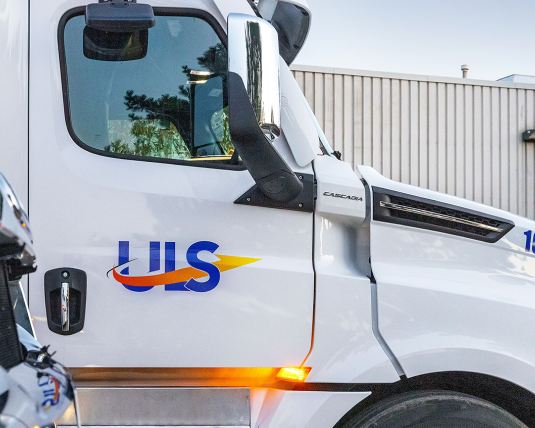Quebec to New York Cross-Border Freight: Customs Made Simple
- ULS Freight

Moving freight between Quebec and New York is one of the busiest and most valuable trade corridors in North America. Every day, thousands of trucks cross the border carrying manufacturing materials, consumer products, energy supplies, and industrial equipment. For business owners, the challenge is not moving goods—it’s ensuring the process runs smoothly through customs and compliance checks. Efficient Quebec to New York cross-border freight logistics are essential for maintaining delivery timelines, controlling costs, and keeping your supply chain stable.
Understanding the Quebec–New York Freight Corridor
Trade between Quebec and New York drives regional economies on both sides of the border. Canada–U.S. logistics professionals recognize that Quebec’s manufacturing and industrial base depends heavily on U.S. buyers, especially across New York State and the Northeast corridor. Key routes such as Montreal to New York City and Quebec City to Upstate New York handle significant truck and container volume daily.
For carriers and exporters, this corridor presents both opportunity and complexity. The geography, distance, and customs procedures all affect delivery speed and cost. Smooth operations depend on reliable carriers, complete paperwork, and coordination between customs brokers and drivers. Many logistics planners use cross-border shipping routes through Champlain or Alexandria Bay to minimize congestion and avoid unnecessary inspection delays.
To maintain efficiency, freight managers should:
- Verify each shipment’s documentation before departure.
- Monitor border wait times in real time.
- Schedule loads around non-peak hours.
- Partner with carriers experienced in Canada–U.S. transport logistics.
When these factors align, businesses reduce transit delays, prevent costly penalties, and ensure goods reach their New York destinations safely.
What Cross-Border Freight Really Involves
Cross-border freight shipping is not just about moving a trailer from one country to another. It’s a structured process that combines pickup, paperwork, customs clearance, and final delivery. For most international trucking Quebec to USA routes, the process includes four main steps:
- Pick-up and load inspection: Ensuring the cargo matches its declared type and quantity.
- Document preparation: Generating the bill of lading, commercial invoice, and packing list.
- Customs submission: Filing pre-clearance through systems such as ACI (Canada) and ACE (U.S.).
- Border clearance and delivery: Completing customs review, inspection (if required), and final delivery.
Partnering with a reputable freight forwarding company in Quebec ensures each stage runs without disruption. Professional forwarders maintain customs databases, manage regulatory updates, and communicate directly with U.S. Customs and Border Protection and the Canada Border Services Agency.
The main border clearance process depends on accuracy and timing. Even a small data mismatch in HS codes or declared value can trigger inspection or delay. Reliable logistics partners use digital platforms that synchronize documents, verify classification codes, and provide visibility from pickup to delivery.
Customs Made Simple — Required Documents and Compliance
Customs procedures can seem complicated, but with the right structure, they’re predictable and manageable. Customs clearance Canada–USA shipments rely on the same few core documents. Missing one can cause a delay that costs hours—or even days—at the border.
Essential Document | Purpose | Issued By |
Commercial Invoice | Declares goods value and origin | Exporter |
Bill of Lading (BOL) | Confirms shipment details | Carrier |
Packing List | Lists item quantities and weights | Shipper |
Certificate of Origin (CUSMA/USMCA) | Verifies North American origin | Exporter |
Import/Export Permit (if applicable) | Authorizes controlled goods | Government Agency |
A professional customs brokerage service ensures all these documents are complete and compliant before the shipment departs. Brokers are experts at handling USMCA documentation compliance, electronic filing, and pre-clearance through ACE and ACI systems.
To simplify customs:
- Use standardized templates for invoices and certificates.
- Verify HS codes and tariff numbers with your broker.
- Submit digital pre-clearance 24 hours before crossing.
- Keep all records for at least five years for audits.
When companies manage these details properly, they shorten clearance times, lower fines, and build a reputation for reliability. If you’re moving regular loads, partner with a broker who offers continuous filing and 24/7 customs support.
See how our customs brokerage experts handle US–Canada freight with zero delays.
Choosing a Reliable Cross-Border Freight Partner
Selecting the right Quebec freight forwarding company is the most critical decision for consistent delivery. A trusted Canada–U.S. trucking company not only transports your cargo but also acts as your compliance partner.
To choose the right logistics provider, look for:
- Proven experience in international logistics and customs brokerage.
- Licensing and bonding across Canada and the U.S.
- A digital tracking system that offers real-time visibility.
- In-house staff for reliable customs broker services.
Avoiding mistakes like unverified carriers or incomplete paperwork can prevent penalties and costly rejections at customs. Reputable international logistics partners coordinate with border authorities daily, making sure every manifest and permit meets regulatory standards.
When businesses align with professional freight providers, they gain more than transport—they secure peace of mind. Reliable partners minimize compliance risks, optimize routes, and deliver consistent performance across the North American logistics corridor.
Get a cross-border freight quote from our Quebec logistics team today and keep your deliveries moving without interruption.
Cost Factors and Transit Time Explained
Business owners always ask two questions: How much will it cost? and How long will it take? The answers depend on multiple factors within freight shipping cost Quebec to New York calculations.
Cost Factor | Influence on Pricing |
Distance & route | Longer routes and detours increase total cost |
Cargo type & weight | Heavy or fragile goods require specialized trailers |
Border wait times | Unexpected congestion can extend driver hours |
Documentation accuracy | Errors cause costly holdovers or re-inspection |
LTL vs. FTL shipping | LTL is cheaper but slower; FTL offers speed and control |
Typical transit times Canada to USA range from 1 to 3 days depending on route, inspection status, and delivery distance in New York. Full Truckload (FTL) shipments offer direct delivery, while Less Than Truckload (LTL) consolidates freight, optimizing cost for smaller loads.
The best carriers provide transparent cross-border freight rates, offering itemized quotes that include fuel surcharges, tolls, and permit costs. When evaluating proposals, request breakdowns by category rather than a single total. This ensures fair comparison and prevents hidden fees.
For accuracy and savings, use carriers that apply digital pricing systems linked to live fuel indexes and toll updates.
Request a detailed freight cost estimate to plan your next Quebec–New York shipment confidently.
Common Challenges in Cross-Border Freight (and How to Avoid Them)
Every logistics manager knows cross-border operations come with challenges—but most issues can be prevented through preparation. Typical pain points include border delays Canada–USA, customs inspection issues, and freight documentation errors.
Here’s how to avoid them:
- Missing paperwork: Use digital document systems that verify completeness before departure.
- Incorrect HS codes: Confirm tariff codes with your customs broker to match product type.
- Driver delays: Plan rest hours and alternate crossings to minimize time loss.
- Transport compliance Canada: Stay updated with regulatory changes from both CBSA and U.S. CBP.
Technology plays a vital role. Integrated EDI (Electronic Data Interchange) systems automatically sync invoices and manifests between carriers, brokers, and shippers. Experienced teams combine digital accuracy with human review to eliminate last-minute corrections.
Download our cross-border freight checklist to prevent common compliance mistakes before your next shipment.
Quebec–New York Trade Insights
Trade between Quebec and New York continues to grow year over year, making this corridor one of North America’s most active routes. According to Statistics Canada and the U.S. Census Bureau, Quebec exports billions in goods annually to New York State, primarily in manufacturing, energy, and consumer products.
Category | Estimated Annual Value (CAD) |
Automotive & parts | $1.8 billion |
Machinery & industrial equipment | $1.2 billion |
Plastics, metals & chemicals | $900 million |
Agricultural & food products | $650 million |
Consumer & retail goods | $500 million |
These figures prove the importance of efficient Quebec export logistics and U.S.–Canada trade volume management. Manufacturers in Montreal and Quebec City depend on reliable cross-border partners to sustain production cycles and meet retailer demand across Upstate New York and the U.S. East Coast.
Strong logistics performance contributes to economic stability. When border efficiency improves, small and medium-sized exporters gain competitiveness and expand into new markets.
How Technology Simplifies Cross-Border Logistics
Modern logistics relies heavily on digital innovation. Tools like freight tracking systems, GPS and route optimization, and automated customs documentation help carriers and shippers eliminate uncertainty.
Smart digital freight platforms connect shippers, drivers, and brokers on a single interface. Features such as electronic proof of delivery, route alerts, and ETA notifications ensure transparency for clients. GPS technology improves route optimization by analyzing live border traffic and weather data.
Advanced telematics also help carriers reduce emissions and fuel costs, aligning with sustainability goals. With automation, customs filings reach authorities in seconds rather than hours, reducing clearance time significantly. For companies managing continuous shipments between Quebec and New York, adopting digital platforms means faster delivery and fewer human errors.
Discover how our smart logistics technology solutions enhance accuracy, safety, and sustainability across the Quebec–New York corridor.
Move Your Quebec–New York Freight with Confidence
Cross-border freight success depends on preparation, precision, and partnership. Whether you’re a manufacturer in Quebec, a distributor in New York, or a carrier operating along this route, seamless Canada–U.S. logistics is the key to efficiency and profitability.
Choosing an experienced logistics partner means fewer compliance risks, faster delivery, and full visibility from pickup to customs clearance. When every document is accurate and every mile is planned, delays disappear—and business moves forward without disruption.
Request your personalized freight quote today and experience how professional logistics turns complex customs into a simple, streamlined process.
FAQ — Common Cross-Border Freight Questions
Yes. Brokers ensure all documentation complies with both U.S. and Canadian regulations, avoiding inspection delays and penalties.
Absolutely. LTL shipments are cost-effective for smaller loads, but make sure your carrier consolidates efficiently to prevent routing delays.
Champlain, Alexandria Bay, and Trout River are preferred for freight due to established customs facilities.
Submit all documentation in advance, use digital filings, and confirm HS codes and product descriptions.
Some carriers provide weekend or after-hours delivery, depending on broker and customs availability.
About ULS Freight
We are Road freight forwarder based in Canada, and offering our road freight services all across the USA, Canada, and Mexico for the last 10 years.
Recent Posts

The Global Supply Chain Crisis: How Logistics Companies Are Responding

Cross-Border Freight Challenges: Navigating Compliance in a Global Market

